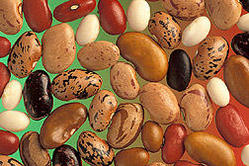Ruth
Art Workshop
Summary of Lesson Activities:
Children will hear the story of Ruth and talk about how we can welcome others. They will make a mosaic “Welcome” sign for home out of grains and seeds, to remind them of Ruth’s gleaning.
- Various beans and seeds (get a variety of colors and textures, rice can also be used as a filler)
- Bristol board (also sometimes known as "railroad board") or cardboard, one per student; cut to size to be able to fit the word "Welcome" in block letters (Size these so that they are smaller for younger students.)
- Sticky paper for collages and mosaics (such as clear contact paper)
- Pencils, scissors, glue (Or a hot glue gun - only one is needed)
- Stickers with the memory verse printed on them
Preparation:
- Apply the sticker with the Bible memory verse to the back of the boards.
- Cut pieces of contact paper slightly larger than the bristol board. (Don't expose the sticky side of the paper yet!)
- For the younger children, lightly write out “WELCOME” on the front of the bristol boards.
- Lay the contact paper on the front of the bristol board, with what would be the sticky side, facing up. Use glue (or a hot glue gun) to attach the non-sticky part of the contact paper to the bristol board. Trim the contact paper to fit exactly, removing any overhanging edges. Allow glue to dry.
- Just before start of class, carefully pull the backing off of the contact paper to reveal the sticky side. This will be the surface on which students will create a mosaic.
- Put the seeds and grains into small bowls and distribute them around the tables
Presentation
Opening-Welcome and Lesson Introduction:
Welcome the children and ask them to sit down. (The children have just prayed in Opening, but you are welcome to lead them in a prayer yourself.)
Especially during the first week, it will be important to explain some of the concepts that the children should be listening for in the story. You can do this before you read the story or during the story, as you see fit. Including explaining...
- Why Elimelech and his family needed to go to Moab.
- Why Naomi felt she needed to return to Israel.
- Why it’s such a big deal for Ruth to stay with Naomi
- The concept of “gleaning”—what it means and why it was "commanded."
- The concept of caring for the outcast and the poor and the foreigner.
Dig-Main Content and Reflection:
The Story of Ruth:
Show the children where the story of Ruth is found in the Bible. (If it’s the second or a subsequent week, you can ask the children if they can show you where the story is found in the Bible.)
Read the story of Ruth from Little Children’s Bible Books: Ruth, retold by Anne de Graaf and illustrated by José Pérez Montero (Nashville: Broadman and Holman, 2000).
Answer any questions that the children may have.
Talk about the similarity between God’s Covenant with us and Ruth’s covenant with Naomi. Can we see God keeping His promises in the story of Ruth?
Art Activity
Ask the children, “What did Boaz do that was so wonderful?” (he married Ruth, helped her get food, helped take care of Naomi, etc. But lead them toward the answer that he WELCOMED Ruth, a foreigner, to his fields and his home.)
Talk about how we can welcome people—what are the things we do to make people feel welcome? Ask them if they have ever felt unwelcome: what did it feel like? What made them feel unwelcome? What should be done differently?
Explain that the children will be making “Welcome” signs for their homes using a mosaic technique and seeds and grains. Ask them why we are using grains and seeds for this art project; lead them to see that this helps remind us of the gleaning for grain that Ruth did in the fields.
Make sure children write names on the backs of the mosaics.
Show them how the sticky paper works and tell them that they should do the WELCOME letters first and then using contrasting colors to fill in the rest of the sheets.
Closing:
Ask the children to help you clean up.
If time, for a follow-up discussion, brainstorm some other ways we can make people feel welcome—at home, at school, at church.
Close with prayer.
Resources:
- Graaf, Anne De, and José Pérez Montero. Ruth. Nashville, TN: Broadman & Holman, 2000. Print.
- Misra, Kimberly. "Dried Bean Mosaics." BellaOnline's Crafts for Kids. 2013. Web. <http://www.bellaonline.com/articles/art67469.asp>.
- Picture of beans/seeds is in the public domain as it came from the Agricultural Research Service, the research agency of the United States Department of Agriculture.
A lesson written by Susanna Muzzin from: Antioch Evangelical Lutheran Church
Farmington Hills, MI
A representative of Rotation.org reformatted this post to improve readability.




